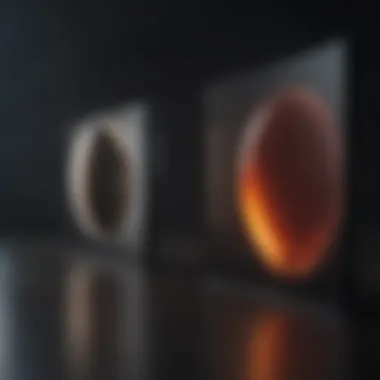Comparing OLED and QLED TVs: Key Differences Explained


Intro
In the rapidly evolving landscape of television technology, the debate between OLED and QLED units emerges as a crucial point for discerning consumers. As home entertainment becomes a centerpiece of leisure activities, understanding different screen technologies is vital for an informed purchasing decision. This piece aims to dissect these TV technologies, highlighting their strengths and shortcomings through a detailed lens.
Overview of OLED and QLED Technology
Both OLED (Organic Light Emitting Diode) and QLED (Quantum Dot Light Emitting Diode) illuminate a promising composite of display qualities, each with distinct characteristics that cater to various consumer preferences. The fundamental difference lies in the way they produce light and color, ultimately impacting the viewing experience.
- OLED technology operates by utilizing organic compounds that emit light individually. As a result, it provides remarkable contrast ratios, deeper blacks, and vibrant colors. The absence of a backlight allows each pixel to illuminate independently, yielding high levels of precision in color representation.
- QLED incorporates quantum dots with traditional LED backlighting. These quantum dots function as filters, enhancing color brightness and range through the process of light emission. QLED TVs are reputable for their high brightness and vivid colors, making them effective in well-lit environments.
This overview sets the stage for a deeper exploration of each technology in terms of picture quality, viewing angles, and price points.
Picture Quality
Picture quality stands as one of the most paramount considerations for potential TV buyers. OLED TVs excel in scenarios requiring deep blacks and dynamic color shifts. Each pixel's ability to turn on or off independently offers scenes with sharp detail and contrast.
In contrast, QLED TVs might shine brightly when evaluated in terms of color reproduction and brightness. They can easily illuminate larger spaces, performing exceptionally well in environments flooded with ambient light. Yet, their black levels may not quite measure up to OLED performance, which could impact certain viewing experiences, particularly in dark-room settings.
Viewing Angles
Viewing angles can significantly influence how a screen performs in various arrangements. OLED technology tends to provide excellent viewing angles; as colors and contrast remain consistent across different positions in the room. This ensures that whether viewers are sitting in the middle or off to the side, the image retains fidelity.
QLED performs adequately when viewed head-on, but as viewers shift to more extreme angles, particularly with larger screens, the visual experience may diminish. Colors can appear washed out, highlighting a potentially significant drawback of this technology.
Brightness
Brightness may often be considered a double-edged sword in performance assessments. QLED displays generally outperform OLED TVs in maximum brightness levels. For viewers who demand striking visuals in bright environments, this high output factor could be a predominant advantage for QLED TVs.
However, extreme brightness in QLED screens may lead to a phenomenon termed as
Prelude to OLED and QLED
Understanding the differences between OLED and QLED display technologies is essential for those serious about visual experiences. Whether you are a gamer seeking high frame rates or a film critic insists on accurate colors, this comparative analysis serves a purpose. As two leading technologies today, OLED and QLED reflect distinct engineering philosophies that impact your enjoyment and perception of content.
This section outlines the basics of both technologies. Equipped with this knowledge, readers can discern personal preferences, identify key advantages of each display type, and image quality considerations when making a purchase. The emphasis here is not solely on technical jargon; rather, it’s aimed at providing clarity.
Definition of OLED Technology
Organic Light Emitting Diode (OLED) technology is known for its unique properties. In an OLED display, each pixel is its own light source. They generate light and color independently, generating deep blacks and vibrant colors. This characteristic makes OLED very appealing for various visual applications, especially for those who gravitate towards cinematic experiences.


Some noteworthy aspects of OLED include:
- Self-emissive nature reducing the need for backlighting.
- Exceptional black levels, resulting in high contract ratios.
- Faster response times, beneficial for gamers and fast-paced content.
- Potential risks of
Comparative Analysis of Display Technologies
Comparative analysis of display technologies is crucial when discussing modern television options. As technology advances, so do consumer choices. Understanding the key differences and similarities between OLED and QLED televisions can assist buyers in finding the right fit for their needs. Both technologies boast unique characteristics that cater to specific viewing preferences, making it essential to delineate their attributes clearly. Factors like brightness, color scope, and viewing angles significantly impact the user experience. This analysis aims to explore these aspects so that readers become adept at distinguishing between the technologies, paving the way to informed purchasing decisions.
Mechanism of Light Production
The mechanism of light production differentiates OLED and QLED fundamentally. OLED, which stands for Organic Light Emitting Diode, generates its illumination at the pixel level. Each pixel in an OLED screen emits its own light. This results in precise control of light and exceptional contrast ratios, capable of achieving perfect blacks. Conversely, QLED, or Quantum Dot Light Emitting Diodes, uses a backlight that passes through a layer of quantum dots to enhance color and brightness. QLED screens cannot achieve the same black depth since they rely on a light source behind the pixels. This foundational difference is essential to consider, especially for those prioritizing picture quality in dark environments.
Brightness and Peak Performance
Brightness is a vital factor that influences how an image is perceived. QLED displays generally excel here due to their use of a bright LED backlight. They can maintain high levels of brightness and perform splendidly in well-lit settings such as sunrooms or bright living rooms. On the other hand, OLEDs, while impressive in color accuracy, might not reach the same peak brightness levels. However, OLED displays shine in dim environments where their ability to produce rich colors and deep blacks takes precedence. This prominence depends significantly on the viewing conditions.
OLED screens possess the unique capability to dim individual pixels, leading to exceptional contrast that QLED cannot match.
Color Accuracy and Range
When discussing color accuracy, both technologies exhibit distinct advantages. OLED panels benefit from their light-emitting nature, which allows them to create vivid colors and a broader range of shades. The perfect blacks achieve exceptional contrast, leading to user-acclaimed image quality across various types of content, including films and video games. QLED, however, leverages quantum dot technology to enhance color saturation, effectively improving overall picture quality. This technology can better handle bright scenes, producing vibrant hues that dominate a well-lit environment. Conclusively, while OLED usually has the edge in darker scenes, QLED can stand out in bright conditions.
Black Levels and Contrast Ratio
Black levels and contrast ratio significantly impact the enjoyment of visual media. OLED's design helps achieve true black since it can completely turn off individual pixels. This characteristic produces stunning realism in darker scenes, making them particularly appealing for movie enthusiasts. In contrast, QLED, constrained by its backlighting, struggles to provide specific pixel-level control. Although QLED displays can create deep blacks to some extent through local dimming, the lack of pixel-by-pixel illumination hinders its ability to produce the level of depth that OLED manages with ease. For disparities in shadowy scenes, OLED usually offers a more immersive experience.
Viewing Angles
Viewing angles influence how well a display performs from different positions within the room. OLED excels in this area thanks to its design, providing consistent color and brightness regardless of the angle. The characteristics assist those navigating larger groups of viewers or laying beyond traditional viewing positions. Meanwhile, QLED screens tend to experience color shift and brightness loss when viewed off-center. Individuals interested in expansive home theater settings should keep these discrepancies firmly in mind. Ultimately, OLED may prevail for those valuing consistent quality across different vantage points.
Impact of Content and Environmental Factors
Understanding how content and environmental factors influence the experience with OLED and QLED TVs is essential for consumers. The quality of the source material shows how the televisions perform. Content variations can affect overall impressions. In addition, the environment where the TV is placed can impact picture clarity and viewing pleasure. This section focuses on optimal viewing conditions and unpacks the significant role room lighting plays in the final experience.
Optimal Viewing Conditions
When discussing optimal viewing conditions, considerations involve distance and angle from the screen. For the best outcomes, viewers should plant themselves at the right distance – usually between 1.5 to 2.5 times the diagonal screen size for clearer details. Sitting directly in front grants a better picture, particularly with OLED displays, which can incorporate irregular viewing experiences depending on placement.
Here are a few elements to think about regarding optimal viewing conditions:
- Distance: Aim for that mentioned distance to enhance clarity.
- Angle: Stay within the frontal viewing angles for OLED; otherwise, colors might wash out.
- Water-building Factors: Consider other components like sofas placement and space setup for maximum effect.


Impact of Room Lighting
Room lighting can drastically impact the performance and enjoyment of content shown on these displays. Ambient light can bring advantages or disadvantages, influencing image contrast and watch catharsis. For instance, in bright rooms, QLED TVs tend to perform better due to higher brightness. Their quantum dot technology reflects sunlight efficiently. In contrast, OLEDs may struggle with sunlight, leading to reflections.
Recognizing how room lighting plays a role is essential to providing recommendations. Here are a few factors:
- Bright Environments: QLEDs outperform OLEDs, presenting better viewing experiences.
- Controlled Lighting: For movies, dim lighting significantly improves OLED’s contrast levels, creating richer visuals.
- Window Size and Positioning: Big rooms with larger windows cause reflections depending on the time of day and play a can spoil the performance of both technologies sometimes, emphasizing the importance of placement position.
Long-Term Performance and Lifespan
The longevity of a television is an essential aspect for many consumers. As technology continues to evolve, understanding how different types of displays perform over time becomes paramount. For both OLED and QLED TVs, long-term performance can influence purchasing decisions. Key factors to consider include potential screen burn-in for OLED displays and the durability of QLED panels. Knowing these aspects helps you choose the technology fit for your viewing habits and lifestyle.
Burn-In Issues in OLED TVs
One of the most discussed topics in OLED technology is the burn-in issue. Burn-in occurs when static images remain on the screen for extended periods, leading to those images being
Price Comparison and Value for Money
Exploring the financial aspects of OLED and QLED TVs is crucial for informed purchasing. Understanding how these technologies differ in terms of initial costs, maintenance, and ownership can greatly impact overall satisfaction. This section emphasizes the economic factors that potential buyers should consider before making a choice between OLED and QLED technologies.
Initial Costs of OLED vs.
QLED
When assessing the initial costs, the average pricing for OLED units typically surpasses that of QLED models. OLED displays generally offer pioneering features such as self-emissive technology, allowing each pixel to emit light independently. These characteristics contribute to higher manufacturing costs, which are reflected in the retail price. Brands like LG and Sony produce elite OLED ranges known for vibrant colors and black levels.
In contrast, QLED TVs, such as Samsung's, are often more affordable. These models utilize a different technology where a backlight illuminates a layer of quantum dots. This production process tends to reduce costs, making QLED a popular choice for budget-conscious consumers.
Key points to keep in mind include:
- OLED TVs may be priced higher, especially for large-screen sizes.
- QLED TVs offer a broader range of lower-budget options together with.
- Stock availability and promotional discounts can influence specific prices.
Cost of Ownership and Maintenance
In terms of cost of ownership, both OLED and QLED possess distinct considerations that can impact long-term budgets. Maintenance costs are typically low for both technologies if properly cared for. OLEDs are prone to ''burn-in'', where static images can cause permanent damage over time, a phenomenon that could necessitate repairs or even replacement.
Meanwhile, QLEDs do not present this risk, as their technology prevents burn-in issues, promoting a longer lifespan under diverse viewing conditions. Factors to consider include:
- Electricity costs may vary, as OLEDs may consume more power than QLEDs when displaying bright scenes.
- Warranty coverage and extended service plans can protect the investment for both types.
- Resale value for newly released models can fluctuate, impacting the investment fluency as newer technologies enter the market.
Key Takeaway: When making a choice between OLED and QLED, consider both the initial cost and the potential long-term costs associated with ownership. Think critically about your viewing preferences and align them with economic sense to find the best option.


Ultimately, the choice between OLED and QLED involves both a top-level investment and an analysis of future costs. An informed decision should cater to present needs while also considering how usage might evolve over time.
User Reviews and Industry Consensus
The section on user reviews and industry consensus serves an important role in comparing OLED and QLED technologies. As consumers dive deep into their purchasing decision, the insights drawn from real-life user experiences can be invaluable. While specifications may highlight differences on paper, it is user-feedback that often reveals how these technologies perform in everyday use.
Consumer Preferences
When it comes to televisions, personal preferences heavily influence buying choices. Many consumers lean toward OLED TVs for their superior black levels and contrast ratios. Users appreciate this technology for its vibrant colors and overall picture quality.
Conversely, QLED fans praise this technology's brightness and enduring quality. This is crucial for people who view content in well-lit rooms. Review analysis can often showcase regional user preferences, as some reports suggest.
Key aspects consumers mention include:
- Black levels and contrast
- Color vibrance and accuracy
- Price to performance ratio
- Lifespan and durability
"User feedback reveals a strong bias towards OLED for darkroom viewing, while QLED frequently stands out in brighter environments."
These preferences help underline which technology aligns best with specific viewing environments and habits. Users looking for exceptional cinematic experiences may find OLED more appealing, while gamers, especially those with lights on around them, might prefer QLED.
Expert Opinions
Industry experts often consolidate findings from various tests and use-state analyses. They verdify what users commonly point out while considering technical parameters. For example, some industry reviewers argue that the image quality difference is less distinct in casual usage, while others insist that calibration can solve many shortcomings.
Industry criticism may emerge from comparisons based not indicate totals buton panel types, as both brands develop different capabilities. Key pointers that experts clarify include:
- Calibration: Many OLED devices need fine-tuning for optimal performance.
- Burn-in vs Longevity: Experts recognize the potential burn-in issues that OLED may face.
- Price Trends: Experts report that QLEDs often offer better deals, highlighting better eras particularly in the mid-range market.
In handling the culmination of viewpoints from the casual viewer to the seasoned expert, a balanced summary of the technologies ensures informed decisions—whether for bright living rooms or dedicated dark rooms.
Closure: Choosing Between OLED and QLED
Selecting between OLED and QLED technologies involves analyzing various factors tailored to individual needs. This conclusion carries weight beyond mere specifications; it encapsulates preferences in usage, content type, and viewing environments.
Both OLED and QLED have unique advantages and limitations. It's vital to engage in this discourse with clarity. Understanding these nuances makes a larger impact on the decision-making process.
Summary of Key Differences
- Technology Style: OLED utilizes organic compounds to create light and color, while QLED relies on quantum dots alongside an LED backlight.
- Contrast and Black Levels: OLED typically displays deeper blacks due to its pixel-level illumination, whereas QLED shines in brightness, benefiting well-lit spaces.
- Color Accuracy: QLED tends to outperform OLED in the vividness of colors, particularly under bright conditions.
- Lifespan and Burn-In Risk: OLED screens may suffer from burn-in over long-term use, a consideration for gamers and those who view static images for extended periods. QLED does not present this issue.
- Price Points: Generally, OLED models are priced higher than most QLED offerings, which might impact accessibility for some consumers.
Recommendations Based on Viewing Habits
When choosing a display technology, awareness of personal viewing habits and preferences is essential:
- For Gamers: If gaming marathons are the norm, a QLED might serve better, aiding with diverse lighting and reducing burn-in risk.
- For Film Buffs: An OLED could be the favorable choice for movie viewing in darker conditions,; enjoying its contrast and black levels enhances the cinematic experience.
- General Viewing in Bright Spaces: QLED serves well in bright rooms with many windows. With superior brightness and color representation, it's designed to thrive despite ambient light.
- Mix of Usage: A user who engages in occasional gaming, but also values cinematic experiences, may consider OLED as a diverse solution with careful treatment to mitigate risks.
Ultimately, each individual's lifestyle and preferences subjectively influence technology choice. Hence, thorough exploration backed by informed analysis lays the groundwork for selecting between OLED and QLED. Careful analysis paves pathways to insightful and satisfying decisions.















